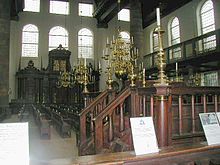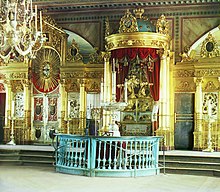Bema: Difference between revisions
m →Judaism |
Expanded the etymology of this Hebrew/Greek/ ancient Semitic word |
||
| Line 1: | Line 1: | ||
{{Two other uses|architectural feature|the eschatological concept|Christian Eschatology||}} |
<ref></ref>{{Two other uses|architectural feature|the eschatological concept|Christian Eschatology||}} |
||
{{unreferenced|date=February 2010}} |
{{unreferenced|date=February 2010}} |
||
[[File:Pnyx albumen.jpg|thumb|The bema or speaker's platform at the [[Pnyx]] in [[Athens]]]] |
[[File:Pnyx albumen.jpg|thumb|The bema or speaker's platform at the [[Pnyx]] in [[Athens]]]] |
||
| Line 5: | Line 5: | ||
[[Image:Gorskii 03982u.jpg|thumb|Bema in an Eastern Orthodox church, with three steps leading up to it. ([[Assumption Cathedral in Smolensk]]).]] |
[[Image:Gorskii 03982u.jpg|thumb|Bema in an Eastern Orthodox church, with three steps leading up to it. ([[Assumption Cathedral in Smolensk]]).]] |
||
The '''Bema''',''' Bima''' or '''Bimah''' ( |
The '''Bema''',''' Bima''' or '''Bimah''' (the post-Biblical [[Hebrew language|Hebrew]]: bima (''בּימה''), "platform or pulpit" is either derived from the Biblical [[Hebrew language|Hebrew]]: bama (''בּמה''), “High Place”, or else from the [[Ancient Greek]] word for a raised platform, "bema" - in modern [[Greek language]] ''βήμα''. However the Ancient Greek may itself be borrowed from the Semitic root, via Phoenician.<ref>{{cite web|url=http://www.balashon.com/2006/10/bamah-and-bimah.html|work=According to William Albright.|accessdate=10/11/13}}</ref> In antiquity it was probably made of stone, but in modern times it is usually a rectangular wooden platform approached by steps. |
||
==Judaism== |
==Judaism== |
||
Revision as of 20:35, 10 November 2013
Cite error: There are <ref> tags on this page without content in them (see the help page).Template:Two other uses



The Bema, Bima or Bimah (the post-Biblical Hebrew: bima (בּימה), "platform or pulpit" is either derived from the Biblical Hebrew: bama (בּמה), “High Place”, or else from the Ancient Greek word for a raised platform, "bema" - in modern Greek language βήμα. However the Ancient Greek may itself be borrowed from the Semitic root, via Phoenician.[1] In antiquity it was probably made of stone, but in modern times it is usually a rectangular wooden platform approached by steps.
Judaism
The bema is typically elevated by two or three steps, as was the bimah in the Temple. At the celebration of the Shavuot holiday when synagogues are decorated with flowers, many synagogues have special arches that they place over the bimah and adorn with floral displays. The importance of the bimah is to show that the reader is the most important at that moment in time, and to make it easier to hear their reader of the Torah. A raised bimah will typically have a railing. This was a religious requirement for safety in bimah more than 10 handbreadths high (somewhere between 83 and 127 centimeters). A lower bimah (even one step) will typically have a railing as a practical measure to prevent someone from inadvertently stepping off.
The bema became a standard fixture in Jewish synagogues (see bemah) from which a portion("parashah") from the Torah and the Haftarah are read. In Orthodox Judaism, the bema is located in the center of the synagogue, separate from the Ark. In other branches of Judaism, the bema and the Ark are joined together.
Ancient Greece
The original use of the bema in Athens was as a tribunal from which orators addressed the citizens as well as the courts of law (see Pnyx). In Greek law courts the two parties to a dispute presented their arguments each from separate bemas. Bema was also used as the name for a place of judgement, that is the raised seat of the judge, as described in the New Testament, in Matthew 27:19 and John 19:13, and further, as the seat of the Roman emperor, in Acts 25:10, and of God, in Romans 14:10, when speaking in judgment.
Christianity
The ceremonial use of a bema carried over from Judaism into early Christian church architecture. It was originally a raised platform with a lectern and seats for the clergy, from which lessons from the Scriptures were read and the sermon was delivered. In Western Christianity the bema developed over time into the chancel (or presbytery) and the pulpit.
In Eastern Christianity bema remains the name of the platform which composes the sanctuary; it consists of both the area behind the iconostasion and the platform in front of it from which the deacon leads the ektenias (litanies) together with the ambo from which the priest delivers the sermon and distributes Holy Communion. It may be approached by one or several steps. The bema is composed of the altar (the area behind the iconostasion), the soleas (the pathway in front of the iconostasion), and the ambo (the area in front of the Holy Doors which projects westward into the nave). Orthodox laity do not normally step up onto the bema except to receive Holy Communion.
See also
- ^ According to William Albright. http://www.balashon.com/2006/10/bamah-and-bimah.html. Retrieved 10/11/13.
{{cite web}}: Check date values in:|accessdate=(help); Missing or empty|title=(help)
